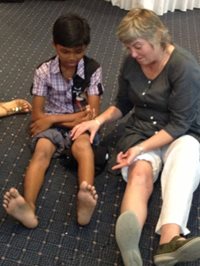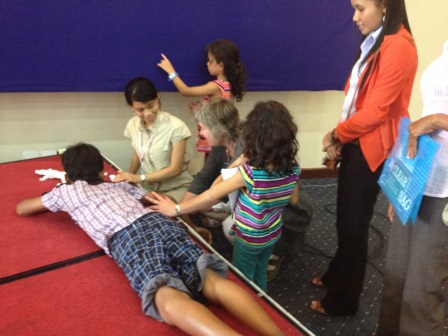COLLEEN MCKAY AND LEE TOWNSEND
Colleen McKay is HFNZ Manager of Outreach Services, and Lee Townsend, is Haemophilia Specialist Physiotherapist at Christchurch Hospital, New Zealand
Haemophilia Foundation New Zealand (HFNZ) is twinned with the Cambodian Hemophilia Association (CHA), Cambodia
In August and September 2013 HFNZ Manager of Outreach Services Colleen McKay and Haemophilia Specialist Physiotherapist Lee Townsend (Christchurch Hospital) travelled from New Zealand to Cambodia for a Twinning Visit.
The annual Twinning Visits are a really important part of the Twinning relationship. They provide a chance to get together in person to review how things are progressing, an occasion for further training and activities and an opportunity to make plans for further development.
One of the main objectives of the Twinning Visit was to deliver a 1-day workshop for families in Phnom Penh, the capital of Cambodia.
The workshop, “Physiotherapy for Hemophilia Patients” was held on Saturday 31 August at the Cambodiana Hotel in Phnom Penh. It was well attended, with 57 participants, including families with children with haemophilia.
Mr Rithy and Ms Tev Linat, volunteer Social Worker with CHA were in charge of communication with members to promote the event. The fantastic attendance and media coverage received was evidence of their success, including coverage on television and in newspapers.
After opening speeches from Mr Kong Sithan and Mrs Colleen McKay, HFNZ , his High Excellency Ung Sambath, Deputy Secretary of the Disability Action Council, a physiotherapist by training, gave an overview of disability in Cambodia and the law that protects the rights of people with disabilities. This was followed by Mr Song Sit, Chairman of Physiotherapy Association in Cambodia on the Cambodian Physiotherapy Association.
 Lee Townsend, Haemophilia Specialist Physiotherapist from Christchurch also travelled with HFNZ to Cambodia to help educate families and health professionals about bleeding disorders. She discussed what happens inside a bleeding joint, how to recognise and treat a bleed, PRICE (Protection, Rest, Ice, Compression, Elevation) and the damage that can occur such as synovitis and arthropathy. She also discussed the importance of exercise and how it can help, especially when little product replacement is available. Lee was also able to assist with individual consultations for those with haemophilia alongside the local physiotherapists and recommend appropriate exercises in order to strengthen muscles and improve joint function.
Lee Townsend, Haemophilia Specialist Physiotherapist from Christchurch also travelled with HFNZ to Cambodia to help educate families and health professionals about bleeding disorders. She discussed what happens inside a bleeding joint, how to recognise and treat a bleed, PRICE (Protection, Rest, Ice, Compression, Elevation) and the damage that can occur such as synovitis and arthropathy. She also discussed the importance of exercise and how it can help, especially when little product replacement is available. Lee was also able to assist with individual consultations for those with haemophilia alongside the local physiotherapists and recommend appropriate exercises in order to strengthen muscles and improve joint function.

After her presentation one patient commented that he now understood what had happened to his knee for the first time and why he is unable to bend his knee as much as he used to. He said he also understood that he would still be able to build up the muscles around the joint in order to keep his legs strong.
The Twinning visit was also an opportunity to meet with the Cambodian Hemophilia Association (CHA) Committee for training on how to succeed as an NMO and plan for the year to come.
HFNZ and CHA representatives also met with a number of stakeholder organisations and institutions including the National Blood Transfusion Center and Disability Action Council.
CHA and HFNZ congratulated the National Blood Transfusion Center on the success of their public blood drives. Due to these they had a supply of regular donors and an excess stock of Fresh Frozen Plasma. Although the Center had sufficient plasma to manufacture cryoprecipitate, they lacked the necessary equipment, trained staff and the room needed to begin. With the increasing number of new diagnoses of haemophilia there was a desire for Cambodia to manufacture cryoprecipitate in order to become self-sufficient in the treatment of those with haemophilia. At that time, the National Pediatric Hospital in Phnom Penh had a very limited stock of donated Factor VIII from the World Federation of Hemophilia (WFH). The manufacture of locally made cryoprecipitate would ensure that it was more likely that people with haemophilia in Cambodia would be able to have treatment for their bleeds. A plan was made to try to help source the necessary equipment and training for staff.
During their meeting with the Disability Action Council they discussed the important steps that had been achieved for those with haemophilia and the importance of access to physiotherapy. For example, haemophilia had been recognised and listed as a disability which gives people with haemophilia in Cambodia rights under the Law on the Protection and the Promotion of the Rights of Person with Disabilities.
The visit also included visits to two physiotherapy clinics – one at the National Pediatric Hospital and one at an NGO-run clinic, the Kien Khleang Rehabilitation Clinic which is run by Veterans International Cambodia. In contrast to the Physiotherapy Department at the National Pediatric Hospital which had very little equipment, the Rehabilitation Clinic was full of physiotherapy equipment and mobility aids. They were also well staffed with physiotherapists, orthotists and prosthetists. They established that this Center is where people with haemophilia requiring mobility aids such as crutches, wheelchairs, and walking frames should come to be fitted with when appropriate. The NGO provides this service and the aids free of charge.
In October 2014 Colleen McKay returned to Cambodia for the final HFNZ-CHA Twinning Visit, along with HFNZ Treasurer Grant Hook and Robert Leung from the World Hemophilia Foundation (WFH).
During the visit representatives of HFNZ and CHA met with the Director of the National Blood Transfusion Service in Phnom Penh. The US Embassy Department of Defence is supporting a new building for the National Blood Transfusion Service and as part of this project funding is secured for the equipment required to manufacture Cryoprecipitate – an important move forwards for Cambodia to be able to provide a treatment product for their patients. Production of Cryoprecipitate is expected to start by early 2015.
This final visit was also a time for HFNZ and CHA to work on structuring CHA’s plans over the next two years. Together with Robert Leung, they also discussed the ways that WFH can assist CHA move forward into this next stage of their development.
It was heartening for HFNZ to be involved in Twinning with CHA and see how they have developed as an organisation over the course of the Twinning Programme. They have a strong core of committed volunteers and many plans for people with haemophilia in Cambodia. Strong bonds have definitely developed between HFNZ and CHA and people with haemophilia in Cambodia will maintain a special place in the hearts of HFNZ members.
To see more about Twinning in Cambodia, see the CHA Facebook page (search for Cambodian Hemophilia Association) or visit the CHA website www.chacambodia.org.
Haemophilia Foundation Australia acknowledges the Traditional Owners and Custodians of Country throughout Australia, the land, waters and community where we walk, live, meet and work. We pay our respects to Elders past and present and extend that respect to all Aboriginal and Torres Strait Islander peoples.
Sign up for the latest news, events and our free National Haemophilia magazine